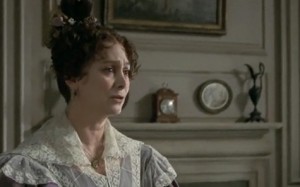The Very Idea Of It
 In the BBC adaption of the Elizabeth Gaskell novel, Wives and Daughters, a rumpled country Squire Hamley played by Michael Gambon, anxiously makes a bid for the help of Miss Molly Gibson (Justine Waddell) in the care of Squire Hamley’s ailing wife.
In the BBC adaption of the Elizabeth Gaskell novel, Wives and Daughters, a rumpled country Squire Hamley played by Michael Gambon, anxiously makes a bid for the help of Miss Molly Gibson (Justine Waddell) in the care of Squire Hamley’s ailing wife.
Unfortunately, Miss Gibson’s step mother, using Molly as a chess piece, insists the girl is not available. She enlarges upon Molly’s social engagements, and observes that an engagement, after all, is an engagement. She keeps repeating this defense, until Gambon erupts with frustration:
“Did I say an engagement was an elephant, ma’am???”
It’s just an explosively funny moment. You can watch it for yourself here:
I suppose it has a lot to do with Gambon’s timing, and with the credible performance of the manipulating step mother, played by Francesca Annis. No doubt, the set design, wardrobe, makeup and editing all contribute, of course, but at the heart of it all is the dramatic idea itself, the story; and the strange, startling reality is that a great story idea is far more valuable than the sum total of all the money spent on everything else, even if you’re budgeting $25 million for George Clooney.
It is true that a camera craning up on a glistening wet field of clover, with an impossibly blue Atlantic ocean fixed in the distance and a winsome pair of Irish lovers walking into frame, hand in hand, all may have the weight of great cinema, but even if you set that all to great music, 45 seconds of pointless dialogue will kill it, even if you have the most sensitive, soulful actors in the world.
I know this is old news, but there’s a condition I think we all suffer from, to one extent or the other, and that’s concentrating on the clothing and not the soul. For years, I’ve had an obsession with cameras, coveting the next best film-kit for the ambitious independent company. I shop post production software. I linger over each page of the B&H Photo/Video catalog. I see someone do something really cool with a tripod crane, so I buy one. I find that a 10 x 10 silk frame is within reach, so I swipe the card, and even as the shipping confirmation is refreshing on the screen, I get that nagging feeling I’ve been doing this to put off working on the blueprint itself.
You might say that someone like James Cameron is the steroid-version of this truth, (glossing over bad story with 3D effects) but it exists all over modern cinema and television. I was watching blip.tv the other day and I couldn’t help noticing that the screen credit graphics looked really inventive and charming, but the stories themselves were a little flat. That’s one of the humbling things about being a writer/director. All of these skills are necessary, and some of them are lovingly devoted to a story that, ultimately, you’re responsible for.
With a few reservations, I think our first two episodes of Courage have qualified as good story, perhaps even great in some places, and I think all of the working hands who have contributed helped clothe an idea that was worth presenting before the court. I just need to remind myself about this from time to time — it’s always the story, Jim. Work on the story.
And just try to avoid ads like this one:

